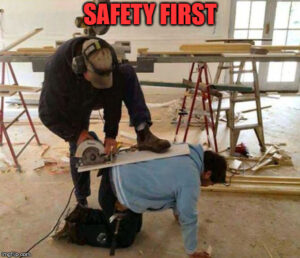What is a competent person and what does this mean for the Portable Fire Equipment on your premises

You must get help from a competent person to enable you to meet the requirements of Irish health and safety law.
A competent person is someone who has sufficient training and experience or knowledge and other qualities that allow them to assist you properly. The level of competence required will depend on the complexity of the situation and the particular help you need.
When getting help, you should give preference to those in your own organisation who have the appropriate level of competence (which can include the employer themselves) before looking for help from outside. You must consult health and safety representatives in good time on the arrangements for competent help.
Guide to the Safety, Health and Welfare at Work (General Application) Regulations 2007
Regulation 13: Fire detection and fire fighting
- Without prejudice to section 11 of the Act, the Fire Services Acts 1981 and 2003
(No. 30 of 1981 and No.15 of 2003) and other relevant legislation,
an employer shall ensure that—
(a) a place of work is equipped with appropriate fire-fighting equipment and, as necessary, fire detectors and an alarm system, taking account of—
(i) the dimensions and use of the buildings,
(ii) the equipment they contain,
(iii) the physical and chemical characteristics of the substances present, and
(iv) the maximum potential number of people present,
(b) non-automatic fire-fighting equipment is—
(i) easily accessible and simple to use, and
(ii) indicated by signs in accordance with Part 7, Chapter 1 and the signs are placed at appropriate points and are adequately durable, and
(c) fire detection equipment and fire-fighting equipment is—
(i) inspected and maintained as frequently as necessary to ensure that it is in good working order, and
(ii) serviced by a competent person as frequently as necessary.
Fire Safety Legislation – Competent Persons Meaning
A/ Definition of a competent person
Safety Health & Welfare at Work Act 2005 –
For the purposes of the relevant statutory provisions, a person is deemed to be a competent person where, having regard to the task he or she is required to perform and taking account of the size or hazards (or both of them) of the undertaking or establishment in which he or she undertakes work, the person possesses sufficient training, experience and knowledge appropriate to the nature of the work to be undertaken.
B/ Definition of a competent person as per IS291
- person, having regard to the task that is required to be performed and taking account of the size and/or hazards of the undertaking or establishment in which the work is undertaken, who possesses sufficient training, experience and knowledge appropriate to the nature of the work to be undertaken.
C/ Safety Health and Welfare at Work Act – General Application Regulations 2007: Regulation 13 – Fire Detection and Fire Fighting “
an employer shall ensure that fire-fighting equipment is serviced by a competent person as frequently as necessary.”
Practical Requirements for Competent Person carrying out the Service of Equipment
What does this mean for you and your company in relation to the Annual Service and Maintenance of Portable Fire Equipment Under IS:291-2015.
1) All extinguishers are refilled and discharged tested in accordance with IS291-2015. This is an amount of 33 1/3% per annum required so over 3 years all extinguishers on your premises are tested.
2) Stored Pressure Extinguishers discharge tested will be fitted with a standard collar which shows the month and year of discharge testing. The only exception to this is CO2 units where a collar is fitted after a pressure test instead. This collar ensures the head of the extinguisher was removed so you can rest assured that the internal body and lining of the extinguisher will be checked during the testing / refilling process.
3) Any extinguishers aged 10 years or older are deemed to be obsolete and will require replacing under IS:291-2015.
4) Weights are recorded when an extinguisher are commissioned and subsequently each year during the Annual Service they must be updated accordingly to monitor any movement or tolerance change in the contents weight of the extinguisher which will effect performance.
5) Factory fitted seals are removed and holding pin is tested every year during Service to ensure the extinguisher can operate as quickly as possible
6) Appropriate signage which is mandatory in place including Fire Point and Extinguisher content Identification Signs.
7) The Fire Register Book for the premises is completed and updated on the day by the competent person carrying out the Annual Service and Maintenance of Portable Fire Equipment.
8) Portable Fire technicians are required to receive third party training to ensure they have the necessary knowledge required to complete their role.
Should you have any questions on this or on any fire safety related matter, please do not hesitate to contact:
GD Gendist Fire & Safety
01 413 7300